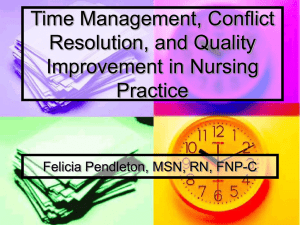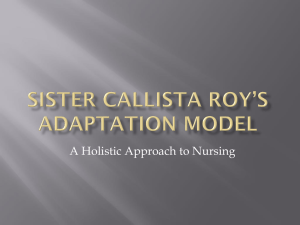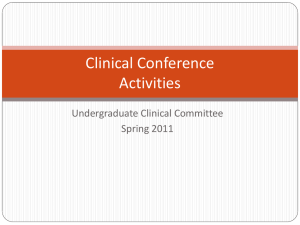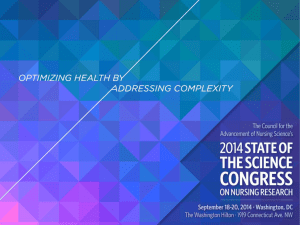Callista Roy*s Adaptation Model
advertisement
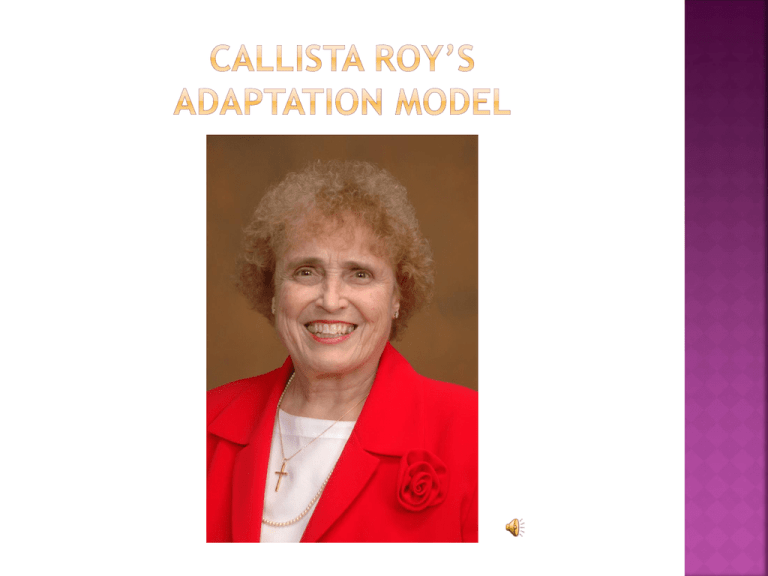
Tracey James Jamie Tornga Tracie Peterson Pamela Eyer Sister Roy worked with pediatrics and noticed the resiliency of children to adapt physically and mentally to their illness In this work, Roy identified a goal of nursing Promoting the patient’s ability of adaptation. With the help of nursing student, over 500 responses from patients were collected from all clinical areas. The four modes of adaptation that were analyzed from the samplings Physiologic Self Concept Role Function Interdependence Sister Callista Roy used this as the foundation of her conceptual model. According to Roy, humans are holistic, adaptive systems. People are resilient and adaptable. Our reading states: “As an adaptive system, the human system is describe as a whole, with parts that function as unity for some purpose” (Tomey, 2006, p. 362). Adaptation occurs through innate or acquired coping mechanisms used to respond to challenging environmental stimuli. Physiological-physical Self-concept – group identity Role Function Interdependence Individuals have basic needs: Five needs Oxygenation Nutrition Elimination Activity Rest Complex processes Fluid balance Electrolyte balance Acid-base balance Complex senses Neurologic function Endocrine function Groups Operating resources Participants Capacities, or jobs Physical facilities Fiscal Resources Need is psychic and spiritual integrity So that one can be or exist within the universe, with a sense of: Unity Meaning Purposefulness Need is group integrity shared through: Shared relations Common goals Common values Co-responsiblity Implications within the group, there must be: Honesty Soundness Completeness of identifications The Knowing who one is in relation to others so one can act Role set for the individual Complex positions the individual holds Ex. Mother, Nurse, Co-worker This need is social integrity involves: Role development Instrumental and expressive behaviors Role taking process Need is Role clarity Understanding and committing to expected tasks So the group can achieve common goals The process of integrating roles in managing different roles and their expectations Ex. Nurse Manager Complementary roles are regulated Ex. Policy and procedures for nurses in the same facility Individual Need is to achieve relational integrity using process of affectional adequacy Ex. The giving and receiving of Love Respect Value This is done through effective relations and communication The need is to achieve relational integrity using processes of developmental and resource adequacy Ex. Learning and maturing in relationship Through interdependence with others The needs for food, shelter, health, and security are achieved. According to Roy, environment is “all the conditions, circumstances, and influences surrounding and affecting the development ad behavior of persons or groups, with particular consideration of the mutuality of persons and earth resources that includes focal, contextual and residual stimuli” (Tomey, 2006, p. 362). The stimuli in which the person must adapt to is in the environment. The Internal sources stimuli can be: Ex. Interpersonal stress External sources Ex. A car coming directly at you Focal The stimuli most immediately confronting the person Contextual The contributing factors in the situation Residual Other unknown factor that may influence the situation When the factors making up residual stimuli become known, they are considered focal or contextual Adaptation is innate and/or acquired, in the individual Regulator subsystem receives input from the external environment or the individual’s internal state The adaptation occurs through physiologic responses by the individual (neural-chemical-endocrine function alters the response) Ex. Increase in heart rate, in response to stimuli Cognator subsystem receives input from external and internal stimuli The adaptation occurs through psychological responses by the individual (cognition, emotion, and past experience) Ex. Laughter in response to stimuli Adaptation responses within the group require: Stabilizer subsystem control process involves the established structures, values, and daily activities used by the group to accomplish its primary purpose and contribute to common purposes of society Ex. Homes and jobs Innovator subsystem control process involves the structures and processes necessary for change and growth in human social systems Ex. Businesses, schools, and education for members of the group. These components within the group subsystems provide basis for a community to remain stable in periods of stagnation. These subsystems allow for sustainability of the group during periods of minor or major change, within the surrounding environment. Roy’s theory can be applied in a 6-step nursing process: 1. 2. 3. 4. 5. 6. Assessment of behavior Assessment of stimuli Nursing diagnosis Goal setting Intervention Evaluation *Doesn’t this sound familiar…. Dr. Roy believes in the link between humans, earth and God. She believes that awareness of self and environment is rooted in thinking and feeling. She believes that humans, the universe, and God have a common destiny. Health can be defined as: A state and process of being and becoming integrated and whole that reflects person and environmental mutuality Adaptation can be defined as: The process ad outcome whereby thinking and feeling, persons, as individuals and in groups, use conscious awareness and choice and human and environmental integration Adaptive resources can be defined as: Responses that promote integrity, in terms of the goals of the human system Goals for the human system: Survival Growth Reproduction Mastery Personal transformation Environmental transformation Ineffective responses can be defined as: Responses that do not contribute to integrity, in terms of the human system Ex. Smoking, Alcohol, and Illicit drugs Adaptation is necessary to maintain health in humans. Our bodies have the ability to adapt to stress and illness. When our bodies are unable to adapt to the stress of an illness: The integrity of the system, as a whole, is compromised Adaptation levels represent the condition of the life processes, described on three different levels Integrated Compensatory Ex. Acid/Base balance is maintained by the entire body Ex. When balance is disrupted, respiratory (lungs) and metabolic (kidneys) compensatory mechanisms try to compensate Compromised Ex. When the initial compensatory mechanism fails, another tries to compensate, which eventually fails. The system is now compromised by an acidosis or alkalosis state. Roy defines nursing broadly as a “health care profession that focuses on human life process and patterns and emphasizes promotion of health for individuals, families, groups, and society as a whole” (Tomey, 2006, p. 361). The nurse gathers data about the patient, as an adaptive system and assesses how the behavior is helping or hindering the adaptive system, in the adaptive models. The nurse must identify stimuli that he or she can amend. A medical diagnosis is not amendable to the nurse. A patient exhibiting pain is amendable to the nurse. Ex. Assessing for pain frequently and intervening with pain medication and therapy, in a timely manner. The nurse must interpret the data about the adaptation status of the patient, including the behavior and most relevant stimuli. The nursing diagnosis is a statement that identifies the behaviors of interest together with the most relevant influencing stimuli. Describes the behavior by the patient and the desired changes the nurse wishes to make in those behaviors. Goals are described in a concise and clear manner, with a measureable timeframe for achievement. Ex. “Patient will verbalize 3 positive coping mechanism for stress by discharge. Goals may be stated for behaviors that need to be changed, as well as for behaviors that should be maintained. This is the management of stimuli The nurse may alter, increase, decrease, remove, or maintain stimuli The nurse implements approaches that have the capability of changing the stimuli or increasing the effectiveness of the adaptive process. The nurse can modify the interventions to enhance the adaptive beings’ ability to adapt to the stimuli. This is when the nurse uses a systematic approach to assess the effectiveness of the interventions and goals. The nurse will assess and reassess the behaviors of the adaptive being and the patient’s behaviors. Two levels of assessment are unique to this model: Behavior and Stimuli Leads to the identification of adaptation problems or nursing diagnosis Basic foundation for writing care plans Theory implications within the individual (patient) and the immediate persons (group) within patient’s environment RAM considers the symbiotic relationship of the individual and the group The individual has impact upon the group The group has impact upon the individual RAM considers these impacts as components of the “whole” patient, in question Classifies environmental stimuli within adaptation Focal – The contributing factors most immediately confronting the person Contextual – The contributing factors in the situation Residual – Other factors that may influence the situation. When factors making up residual stimuli become known, they are considered focal or contextual Provides basis for framework for nursing care, but defines some framework for nursing education and policy Considers the patient, as well as the nurse Explores the patient’s environment further than other theories Ex. Considers aspects of a patient’s home, job, and community to have impact on the his/her adaptability RAM is deeply rooted in nursing practice Most frequently used conceptual framework to guide nursing practice Used nationally and internationally Useful for nursing practice Outlines features of the discipline Valuable theory for nursing practice Includes a goal that is specified, as the aim for activity and prescription for activities to realize the goal Useful for guiding nursing practice in institutional settings Provides direction for Practice Education Research Model considers Goals Values The patient Practitioner intervention The model has been applied to the nursing care of individual groups of people Smokers Caregivers of chronically ill family member Cardiac care units Chronic renal failure patients whom require dialysis Women in menopause Adolescents with asthma This model has been implemented to facility units, including: NICU Acute Surgical units Rehab units Acute Medical units Orthopedic units Neurosurgical units Many others The nurse performs the following six functions Assess the behaviors manifested from the adaptive models Assess the stimuli for those behaviors Categorizing the stimuli as focal, contextual, or residual Formulates a diagnosis of the person’s adaptive state Also known as “Nursing Diagnosis” Sets goals to promote adaptation Implements interventions aimed at managing the stimuli to promote adaptation Alter stimuli Increase stimuli Decrease stimuli Remove stimuli Maintain stimuli Evaluate whether the adaptive goals have been met The process can be repeated many times RAM defines the distinct purpose of the nursing students Distinguishes nursing science from medical practice Stresses collaboration, but delineates separate goals for nurses and physicians Nursing goals Help the patient put their energy into getting well Provides educators with a systematic way of teaching student The students are taught to assess and care for patients within the context of their lives, rather than just victims of illness Taught as a part of curriculum in BSN programs MSN program Doctoral programs in nursing Widely used in research today Continues to be the most commonly used framework Continually being revised and redefined on different occasions Further research is needed Design studies to test propositions related to environment and nursing Have interventions based on the concepts of proposition that have been previously supported RAM continues to make a significant contribution to the body of nursing knowledge Needs to facilitate its use better in the nursing practice More thoroughly defined typology of nursing diagnoses Organization of categories of interventions Roy has currently redefined health, decreasing the emphasis of the concept of health-illness continuum and conceptualizing health as integration and wholeness of the person (Alligood, et al., 2010) When one accomplishes adaptation in each of the 4 responses, it will then contribute to one’s health, quality of life, and being able to die with dignity This model gives a more theoretical approach to be able to answer some of the most pressing questions on how we are to give nursing care This model can be applied to nursing, the patient, the family, and the community. The Adaptation Model is simple to understand and can be applied, not only research, but to nursing practice and education. Gives nurse educators a conceptual framework for their curriculums The RAM is continually evolving due to research, rather than statistics. The four modes offer an opportunity for the consideration in the multiple aspects of the human adaptive system and support, gaining an understanding of the system, as a whole It is the most widely used framework for the guidance of nursing practice Outlines the features of the discipline Provides direction for practice, education and research -Alligood, et al, 2010 According to the model, you will develop multiple interventions to be able to accommodate for different stimuli These interventions will allow you to judge the consequences that could or could not happen and adjust the stimuli accordingly Adjustment allows you to see the value of the change, whether the change is desirable or undesirable. The model is unable to cope with or respond to constantly changing stimuli Most prevalent limitation Time consuming Requires 2 areas of assessment More time consuming in the beginning It can take years to for full implementation and understanding of new theories Easily generalized to all settings of nursing practice, but is limited within the scope Addresses the person-environment adaptation of the patient Information about the nurse is implied - Alligood, et. 2010 Finally, one person’s behavior cannot be conceptualized on a health-illness continuum, because one adaptive mode is affected by the other modes and it is continually changing. Greatly influenced the nursing profession Most frequently used model Guides nursing research Guides education Guides practice RAM has inspired the development of: Middle range nursing theories Adaptation instruments Persons affect and are affected by the environment Environment is the source of stimuli This stimuli can threaten or promote a person’s existence RAM includes concepts of Nursing Health-illness continuum Environment Adaptation Nursing activities Includes subconcepts Regulator Cognater Stabilizer Innovator 4 effector modes Physiological-physical Self-concept – group identity Role function interdependence RAM continues to be one of the most frequently used theories by the nursing philosophy Basis for use has been identified at a national and international level RAM provides the cornerstone of care plan composition RAM is an exciting and ever evolving model that has helped to build a foundation for conceptual nursing. Sister Roy's contribution to the nursing profession is enormous and continues to grow. In what ways have you used RAM in your nursing career? What pro and cons do you see in using RAM in your institution/unit? What step in the RAM process can you most relate to your everyday practice and how? Please respond to these questions in the discussions areas. Also, if you have any additional questions, please feel free to share these questions with the group



